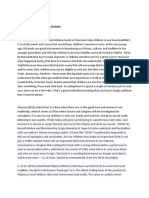Scott W Downs - WR Final Synthesis 12-11-13
Scott W Downs - WR Final Synthesis 12-11-13
Uploaded by
api-241511116Copyright:
Available Formats
Scott W Downs - WR Final Synthesis 12-11-13
Scott W Downs - WR Final Synthesis 12-11-13
Uploaded by
api-241511116Original Title
Copyright
Available Formats
Share this document
Did you find this document useful?
Is this content inappropriate?
Copyright:
Available Formats
Scott W Downs - WR Final Synthesis 12-11-13
Scott W Downs - WR Final Synthesis 12-11-13
Uploaded by
api-241511116Copyright:
Available Formats
Downs 1
Scott W. Downs Professor Suzanne Jacobs Humanities 2300 Section #5 December 11, 2013 The beauty of having begun an investigation of several faiths is in observing their similarities. Meeting a few of their respective followers and growing in understanding of their cultural background allows for improved relationships. It has been my good fortune to participate in numerous religious discussions with those of a variety of faiths. On each occasion the exchange of ideas has broadened my respect and understanding of similarities. Being afforded the opportunity to worship with those of the Hindu, Jewish and Islamic faiths this semester has been a treasure I will not soon forget. Each of the places of worship possessed uniqueness while at the same time bearing similarities. The Khadeeja Mosque provided a wash basin to cleanse feet prior to entering the mihrab space. This outward expression of cleanliness was in harmony with the precept that all who wish to share in the presence of Allah should be inwardly cleansed as well. As the soles of our shoes are dirty, so we should remove them prior to addressing a perfectly clean Being. Similarly, the Hindi Temple required we remove our shoes to leave a measure of our spiritual impurity outside of the Temple that we might, in a more pure fashion, engage with a deity such as Ganesh and any of the other murti more pure. Finally, at the Kol Ami synagogue we were required to place yarmulkes upon our heads to show respect for God. Only now am I recognizing the parallel practice of adorning, or removing, certain specific accoutrements to provide an outward expression of the inward reverence.
Downs 2
The layouts of the worship spaces had consistent patterns, as well as distinct differences from the other faiths. Inside of the mihrab space of the Islamic service, I was surprised to find such an expansive area, thousands of vacant square feet for the faithful to quietly sit upon! Unlike the western religions I am familiar with, we were invited to sit upon the floor and direct ourselves towards the Kabah, eastward. Each worshipper sat or knelt offering silent prayer towards Mecca, with the imam placed at the front-center of the meetinghouse. In consistent eastern religious fashion, at the Sri Ganesh Temple we were invited to place ourselves upon the floor adjacent to fellow worshippers who had come to appeal to, or thank, the Gods for their various needs and blessings. Our orientation was directed towards Ganesh unless the Priest was conducting another ritual with the murti of a different deity. The Jewish faith provided traditional western pews yet all rows were also directed towards the raised pulpit which was in front of the Ark of the Covenant. It can be deduced that we were facing that direction so as to be pointing our thoughts towards the Torah, the commandments we need to recommit to observing. While not something I am prepared to expound upon extensively, I observed that the eastern faiths structures appeared to have more curvature in their architecture. This was reflected inside of the edifices as well as outside. However, I should allow for the spherical corridor which allowed one to walk about the exterior of the inner-sanctum of the Jewish synagogue and access all rooms or services. In comparing the arrangement of sacred emblems I realized that within each central worship location there were insignias to remind and direct thoughts towards communion with God, Brahman or Allah. In the Kol Ami synagogue there was a beautiful, large menorah not far from where the Rabbi spoke. On the floor of the mihrab inside of the Khadeeja Mosque there were emblems of turrets inside of rectangular sections of the
Downs 3
carpet, all pointing towards the Kabah. On the right of the main worship space inside of the Sri Ganesh Temple there were nine astrological murti which served to connect the association of an endless soul, an atman, and the all-powerful God, Brahman. Each of these reminders likely served the worshippers well, allowing them prompts to regain focus if their thoughts drift. In each case these sacred emblems served a functional purpose beyond reminders. In each of these three services there was musical interaction with God. When adoring Allah we were able to join in chorus for the rakas. Most of the Hindi service was conducted by the Priest singing. Similar to Hindu, it seemed as though about half of the Jewish service was a melodic prayer to God. Both the clerics and followers participated at appointed times. Such glorious praises offered by vocally gifted leaders and harmonious congregations. While this interaction was musical, both the Jewish and Hindu faith allowed for physical interaction with God. For the Jews it was by making respectful contact with the Torah as the Rabbi walked about. For the Hindis the Priest also moved among the congregation offering a solution of some sort for tasting and placing in the hair. The Muslims had notable involvement by individually repeating the rakas with the Imam. In harmony with I have learned to be the purpose of Ganesh, worshippers were able to directly implore the God for specific, personal purposes. At the conclusion of the Jewish service, a similar exercise was performed by the Rabbi inviting prayers on behalf of loved ones. Lastly, the Imam at the Khadeeja Mosque invited members of the congregation for particular needs near the conclusion of the service. There appeared to be symmetry in this pattern of vicarious communication to God through the leader of the congregation. Every one of the faiths was so profoundly gracious it was impressive. Upon arrival in each case we received gracious welcomes and instructions to feel involved. The Hindu
Downs 4
congregation invited us to move about and interact with the murti. Following their service the Priest allocated time to respond to inquiries based upon our unfamiliarity with the procedures. At the Kol Ami service we were handed yarmulkes as well as copies of the Torah and Siddur that we might more easily follow the sermon. Once seated, the Rabbi encouraged her congregation to mingle among visitors to assist with keeping pace with the lecture. This was immediately done and I surely benefited from the explanation of which direction the text would flow. At the Islamic sermon I was invited to recite the rakas next to a frequent worshipper. These experiences were so humbling, so moving. Being a visitor to any faith one feels an intruder and in each of these three scenarios I was embraced as one of their own. All of these experiences lead me back to considering those I have known and had the honor of forging lengthy friendships with, and their religious practices. Firstly, our Pakistani and Afghani neighbors who practiced Islam. The Ayubis lived across the hall from our condominium. We shared many a meal together and several parties. Habib taught me to use the expression Id Mubarak as a Happy New Year exclamation. While I mayve used it improperly, he was patient with my attempts to learn more about his culture. On one occasion I made mention of admiration for a child-sized chair which had a sporting theme. At that point I was unaware of placing Habib in a place of religious conflict. Not but two days later he brought home an identical chair as a gift to me. Only later did I learn that in my expression of admiration I was placing him in a position of causing another man to covet, so he wished to remove this sin from me, and thus acquired another similar and gave it to me. Another person I developed a relationship with my office-mate Chandra. Chandra is Hindi and when I learned that chandra means the cycle of the moons I thought of how
Downs 5
appropriate a name this is for such a beautiful and sweet woman. This woman embodies what I believed Hindu to be, a passive religion that is accepting of others and quietly practiced by kind people. As I have learned of Brahman, the Vedas, the Upanishads and about an Atman, my thoughts gravitate back to this wonderful person who I labored with for ten years. It was not uncommon for Chandra to inquire about my weekend religious activities and for this to result in a respectful discussion about the common goal of charity and how it ought to surpass all religious boundaries. She is a dear woman who is constantly demonstrating acts of kindness which welcome good karma to her and her family. In conclusion, I would assert that each of the faithful religious people I have been privileged to know represented their respective religions well. They were open to sharing their beliefs and ideas and welcoming discussions with others about a different perspective. Each of these faiths has the same goal, to live a live worthy of salvation or moksha and earn the right to increased happiness in the next life. The services had similar lecture patterns, wardrobe requirements to properly commune with Deity, layouts that had internal similarities and gorgeous music. All of the experiences were gracious and will prove invaluable for me in my future.
You might also like
- Touching God: A Journey, a Guide to Mysticism in Christianity and IslamFrom EverandTouching God: A Journey, a Guide to Mysticism in Christianity and IslamRating: 4 out of 5 stars4/5 (1)
- WorshipexperiencespaperDocument11 pagesWorshipexperiencespaperapi-336836817No ratings yet
- Position PaperDocument9 pagesPosition Paperapi-341344380No ratings yet
- Thesis Statement Christianity and HinduismDocument6 pagesThesis Statement Christianity and Hinduismuywodgikd100% (2)
- Indigenizing Worship: How Far Should We Go?: Christianity" (Delhi: ISPCK, 2000), XVDocument8 pagesIndigenizing Worship: How Far Should We Go?: Christianity" (Delhi: ISPCK, 2000), XVBenalin C RNo ratings yet
- Ethnography ESSAYDocument10 pagesEthnography ESSAYMalika TamimNo ratings yet
- Comparison PaperDocument8 pagesComparison Paperapi-285100982No ratings yet
- For God's Sake: Understand the Esoteric Truths Behind Your ReligionFrom EverandFor God's Sake: Understand the Esoteric Truths Behind Your ReligionNo ratings yet
- Reflection PaperDocument3 pagesReflection PaperFatima WaseemNo ratings yet
- Thesis Statement On Hinduism and ChristianityDocument5 pagesThesis Statement On Hinduism and Christianitybk32j4wn100% (2)
- Cabezon, Jose Ignacio. Dalai Lama. Answers, Discussions With Western BuddhistsDocument38 pagesCabezon, Jose Ignacio. Dalai Lama. Answers, Discussions With Western BuddhistsVashikaran.OrgNo ratings yet
- Spiritual Guidance Across Religions: A Sourcebook for Spiritual Directors and Other Professionals Providing Counsel to People of Differing Faith TraditionsFrom EverandSpiritual Guidance Across Religions: A Sourcebook for Spiritual Directors and Other Professionals Providing Counsel to People of Differing Faith TraditionsRev. John R. Mabry, PhDNo ratings yet
- Sacred Pathways: Navigating the Depths of Religion and SpiritualityFrom EverandSacred Pathways: Navigating the Depths of Religion and SpiritualityNo ratings yet
- Making of Composite CultureDocument10 pagesMaking of Composite Culturemrclaudexyz710No ratings yet
- How To Become A Sanatan HinduDocument421 pagesHow To Become A Sanatan Hindulovable_pccNo ratings yet
- Unit WDocument9 pagesUnit Wharsha vardhanNo ratings yet
- Spiritwind: A Study Book for Spiritual AdventurersFrom EverandSpiritwind: A Study Book for Spiritual AdventurersNo ratings yet
- BBC Religions - Jesus in HinduismDocument4 pagesBBC Religions - Jesus in HinduismmllabateNo ratings yet
- Sufism The Message of LOVE and COMPASSIO PDFDocument140 pagesSufism The Message of LOVE and COMPASSIO PDFFaiza GandapurNo ratings yet
- Sufism The Message of LOVE and COMPASSIODocument140 pagesSufism The Message of LOVE and COMPASSIODragoș RusuNo ratings yet
- Hinduism & Islam - The Common Thread - Sri Sri Ravi ShankarDocument25 pagesHinduism & Islam - The Common Thread - Sri Sri Ravi ShankarAethestic BeastNo ratings yet
- 1.0.1 WorshipDocument8 pages1.0.1 Worshipesthebabe624No ratings yet
- Worship Site Visit Report Hindu Temple of Central FloridaDocument12 pagesWorship Site Visit Report Hindu Temple of Central FloridaKevin Tomaszewski100% (1)
- Understanding World Religions: Hinduism Buddhism Taoism Confucianism Judaism IslamFrom EverandUnderstanding World Religions: Hinduism Buddhism Taoism Confucianism Judaism IslamRating: 3.5 out of 5 stars3.5/5 (2)
- Research Paper On Spirituality in IndiaDocument4 pagesResearch Paper On Spirituality in Indiahyzypif0gif3100% (1)
- The Call of the Mourning Dove: How Sacred Sound Awakens Mystical UnityFrom EverandThe Call of the Mourning Dove: How Sacred Sound Awakens Mystical UnityNo ratings yet
- Shri+Vidya+Book+by+TRV+ +finalDocument40 pagesShri+Vidya+Book+by+TRV+ +finalkinjal11100% (1)
- Shri Vidya: Bhaskara Prakasha AshramDocument40 pagesShri Vidya: Bhaskara Prakasha AshramPundarikakshasarma Vedam100% (1)
- Bible Studies by Vivienne StaceyDocument7 pagesBible Studies by Vivienne StaceyDuane Alexander Miller BoteroNo ratings yet
- Project 1Document5 pagesProject 1api-666269710No ratings yet
- Come and Sit: A Week Inside Meditation CentersFrom EverandCome and Sit: A Week Inside Meditation CentersRating: 4 out of 5 stars4/5 (2)
- Understanding Islam IDocument23 pagesUnderstanding Islam ISayan RoyNo ratings yet
- Hindu Way of LifeDocument101 pagesHindu Way of LifeSairam KrishnanNo ratings yet
- Hinduism AssignmentDocument4 pagesHinduism AssignmentMichiNo ratings yet
- Rels Position PaperDocument7 pagesRels Position Paperapi-356769323No ratings yet
- SkrrrrrrrrrrepDocument3 pagesSkrrrrrrrrrrepLance Marco A. CapistranoNo ratings yet
- Universalist Radha-Krishnaism: The Way of Natural Devotion: A Practitioner's HandbookFrom EverandUniversalist Radha-Krishnaism: The Way of Natural Devotion: A Practitioner's HandbookRating: 5 out of 5 stars5/5 (1)
- God in All Moments: Mystical & Practical Spiritual Wisdom from Hasidic MastersFrom EverandGod in All Moments: Mystical & Practical Spiritual Wisdom from Hasidic MastersRating: 5 out of 5 stars5/5 (2)
- Why Be A Hindu:: The Advantages of The Vedic PathDocument28 pagesWhy Be A Hindu:: The Advantages of The Vedic PathNeeraj100% (1)
- Particularism and UniversalismDocument7 pagesParticularism and UniversalismLeena TanejaNo ratings yet
- Jewish Spiritual Direction: An Innovative Guide from Traditional and Contemporary SourcesFrom EverandJewish Spiritual Direction: An Innovative Guide from Traditional and Contemporary SourcesRating: 4 out of 5 stars4/5 (2)
- Composite CultureDocument5 pagesComposite Culturearkoprovobagchi2009No ratings yet
- Saintly Intercession in A Sufi DargahDocument28 pagesSaintly Intercession in A Sufi DargahOct888No ratings yet
- Project 1Document4 pagesProject 1api-252560771No ratings yet
- Compare and Contrast EssayDocument4 pagesCompare and Contrast Essayapi-116490609No ratings yet
- Edt 303 Assignment 2Document6 pagesEdt 303 Assignment 2Patience TshabalalaNo ratings yet
- SNMSamagam NC2011Document3 pagesSNMSamagam NC2011ssagar_usNo ratings yet
- Your Word is Fire: The Hasidic Masters on Contemplative PrayerFrom EverandYour Word is Fire: The Hasidic Masters on Contemplative PrayerRating: 4 out of 5 stars4/5 (4)
- Research Paper 103 (C)Document30 pagesResearch Paper 103 (C)Ahsan Farid KhosaNo ratings yet
- Prayer as Memory: Toward the Comparative Study of Prayer as Apocalyptic Language and ThoughtFrom EverandPrayer as Memory: Toward the Comparative Study of Prayer as Apocalyptic Language and ThoughtNo ratings yet
- Eportfolio 1Document8 pagesEportfolio 1api-254067576No ratings yet
- World Religions Final PaperDocument7 pagesWorld Religions Final Paperapi-219047024No ratings yet
- Internet Monopolies - A10 Summary 12-01-14Document2 pagesInternet Monopolies - A10 Summary 12-01-14api-241511116No ratings yet
- Scott W Downs - Global Culture v6 11-17-14Document4 pagesScott W Downs - Global Culture v6 11-17-14api-241511116No ratings yet
- Capitalistic Concussion - Annotated Bibliography 11-11-13Document13 pagesCapitalistic Concussion - Annotated Bibliography 11-11-13api-241511116No ratings yet
- Concussion Speech - Eng Final Draft 11-25-13Document8 pagesConcussion Speech - Eng Final Draft 11-25-13api-241511116No ratings yet
- Emerging Economic Map 10-15-13Document6 pagesEmerging Economic Map 10-15-13api-241511116No ratings yet
- Scott W Downs - Maximizing The Profit of A Business Page 3 12-05-13Document1 pageScott W Downs - Maximizing The Profit of A Business Page 3 12-05-13api-241511116No ratings yet
- Scott W Downs - Maximizing The Profit of A Business Page 2 12-05-13Document1 pageScott W Downs - Maximizing The Profit of A Business Page 2 12-05-13api-241511116No ratings yet
- Greatness Speech - Revised Presentation Outline 12-04-13Document3 pagesGreatness Speech - Revised Presentation Outline 12-04-13api-241511116No ratings yet
- Speech Analysis Final Draft 12-03-13Document4 pagesSpeech Analysis Final Draft 12-03-13api-241511116No ratings yet
- Scott W Downs - Maximizing The Profit of A Business Page 1 12-05-13Document1 pageScott W Downs - Maximizing The Profit of A Business Page 1 12-05-13api-241511116No ratings yet
- Stupid Economic Ideas - Mark BlythDocument22 pagesStupid Economic Ideas - Mark BlythJuliongangoNo ratings yet
- Global Marketing: Tenth Edition, Global EditionDocument26 pagesGlobal Marketing: Tenth Edition, Global EditionXuan JenniferNo ratings yet
- Updates in Labor LawDocument53 pagesUpdates in Labor LawPeter Carlo DavidNo ratings yet
- UNIT 4 Grammar Practice: Reported StatementsDocument1 pageUNIT 4 Grammar Practice: Reported StatementsnataNo ratings yet
- United States v. Fred L. Sanders, 980 F.2d 741, 10th Cir. (1992)Document2 pagesUnited States v. Fred L. Sanders, 980 F.2d 741, 10th Cir. (1992)Scribd Government DocsNo ratings yet
- Makalah PARTICIPLES AND DEGREES OF COMFARISONDocument14 pagesMakalah PARTICIPLES AND DEGREES OF COMFARISONAdila NurfiNo ratings yet
- PARK-So-Jin 2007 Educational-Manager-Mothers-South-Koreas-Neoliberal-TransformationDocument14 pagesPARK-So-Jin 2007 Educational-Manager-Mothers-South-Koreas-Neoliberal-TransformationEsther LópezNo ratings yet
- T3TAAD-Arrangement Architecture DepositsDocument458 pagesT3TAAD-Arrangement Architecture DepositsBejace Nyachhyon100% (1)
- Python - How To List All Files in A DirectoryDocument6 pagesPython - How To List All Files in A Directorymitrasamrat20026085No ratings yet
- Negotiation Practice On Book Publishing - Nedwin - CourseraDocument2 pagesNegotiation Practice On Book Publishing - Nedwin - CourseraedwinNo ratings yet
- Bayern MunichDocument2 pagesBayern Munichapi-348365155No ratings yet
- 1b Students Induction Program OverviewDocument16 pages1b Students Induction Program OverviewgwliorNo ratings yet
- Mad To Be Normal Conversations With RD Laing 1853433950Document408 pagesMad To Be Normal Conversations With RD Laing 1853433950ronwerter6100% (2)
- Auditing in A Computer Information Systems (CIS) EnvironmentDocument4 pagesAuditing in A Computer Information Systems (CIS) EnvironmentxernathanNo ratings yet
- Event Space Rental Agreement and Contract 5aab99851723ddbd6a79429bDocument5 pagesEvent Space Rental Agreement and Contract 5aab99851723ddbd6a79429bMary Ann Farcon VelascoNo ratings yet
- Understanding The Marketing PlanDocument58 pagesUnderstanding The Marketing Planjunver100% (5)
- Studies. Literature2Document5 pagesStudies. Literature2Fabian Regine G.No ratings yet
- IICS R38 Cloud DIS OD 202202 LG E - 637807065150345733Document397 pagesIICS R38 Cloud DIS OD 202202 LG E - 637807065150345733Learn vmajjaNo ratings yet
- A06 - Ch.18 - Muslim World ExpandsDocument2 pagesA06 - Ch.18 - Muslim World ExpandsAnthony ValentinNo ratings yet
- Persuasive LanguageDocument23 pagesPersuasive LanguageChrisNo ratings yet
- 789 TG 7 IvbihpDocument372 pages789 TG 7 IvbihpAparimit PandeyNo ratings yet
- Aa Big IndexDocument2 pagesAa Big IndexKristinDaigleNo ratings yet
- Community Service Scholarship EssayDocument7 pagesCommunity Service Scholarship Essayezmv3axt100% (2)
- I Felt at Home Analysis of Reviews of Collaborative Hosting Experiences On Airbnb Website Under The Prism of TrustDocument16 pagesI Felt at Home Analysis of Reviews of Collaborative Hosting Experiences On Airbnb Website Under The Prism of TrustMateus CruzNo ratings yet
- Sir Syed Ahmed Khan Aligarh MovementDocument2 pagesSir Syed Ahmed Khan Aligarh MovementKashan Ansari60% (5)
- Sociology SynopsisDocument6 pagesSociology SynopsisAditi OhdarNo ratings yet
- God Still Speaks by John EckhardtDocument3 pagesGod Still Speaks by John EckhardtNick0% (3)
- DR Trevor Smith Customer Value PropositionDocument20 pagesDR Trevor Smith Customer Value PropositionrajNo ratings yet
- CHBEA-STYLE-GUIDE-2021.docx 2078-05-23Document12 pagesCHBEA-STYLE-GUIDE-2021.docx 2078-05-23592sw4dgw6No ratings yet
- The Views of Al-Shā Ibī (D. 1388) and Zarrūq (D. 1493)Document12 pagesThe Views of Al-Shā Ibī (D. 1388) and Zarrūq (D. 1493)So' FineNo ratings yet



































































































